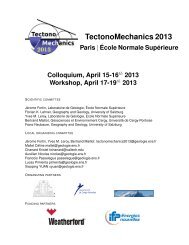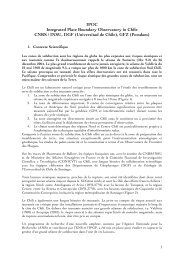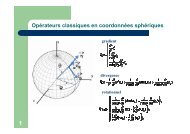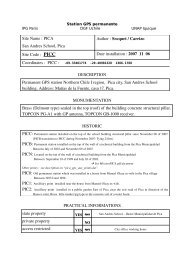PDF file - Laboratoire de Géologie de l'Ecole normale supérieure - Ens
PDF file - Laboratoire de Géologie de l'Ecole normale supérieure - Ens
PDF file - Laboratoire de Géologie de l'Ecole normale supérieure - Ens
You also want an ePaper? Increase the reach of your titles
YUMPU automatically turns print PDFs into web optimized ePapers that Google loves.
MICROBLOCK ROTATIONS IN SULAWESI, INDONESIA<br />
Table 1: Euler vectors used in this study a<br />
Plates pairs<br />
Euler vector<br />
Long (°) Lat (°) ω (°/Myr) Emax (°) Emin (°) Azimuth (°)<br />
Sunda / ITRF2000<br />
[Simons et al, subm]<br />
Mo<strong>de</strong>l 1, GPS only<br />
-48.9 85.8 -0.3<br />
Makassar / Sunda -4.5 117.4 1.5 ± 0.21 0.48 0.26 83 ± 3<br />
North Sula / Sunda 2.4 129.9 -2.5 ± 0.36 2.23 0.17 193 ± 9<br />
Manado / Sunda 1.9 126.6 -3.1 ± 0.99 1.06 0.49 251 ± 3<br />
Banda Sea / Sunda -7.1 118.1 2.0 ± 0.91 6.92 1.30 70 ± 10<br />
East Sula / Sunda<br />
Mo<strong>de</strong>l 2, GPS + Slip Vectors<br />
-8.3 115.7 2.4 ± 1.31 7.35 0.85 43 ± 9<br />
Makassar / Sunda -4.8 117.4 1.4 ± 0.15 0.42 0.21 71 ± 3<br />
North Sula / Sunda 2.4 129.5 -2.6 ± 0.38 1.81 0.32 247 ± 8<br />
Manado / Sunda 1.8 126.5 -3.2 ± 1.99 1.44 0.37 262 ± 3<br />
Banda Sea / Sunda -9.7 113.3 1.8 ± 0.21 2.55 0.63 54 ± 15<br />
East Sula / Sunda -7.9 115.0 2.2 ± 0.55 3.70 0.50 48 ± 9<br />
a<br />
ω is the rotation rate with one standard error. Euler vectors are for the first plate relative to the second one. Emax, Emin<br />
and azimuth refer to the maximum and minimum axes of the 68% confi<strong>de</strong>nce error ellipse and the azimuth of the major<br />
axis respectively. Positive rotation rates indicate anticlockwise motion looking from above.<br />
r<br />
n dof<br />
s<br />
⎟ 2<br />
2 ⎛ ⎞<br />
χ = ⎜<br />
⎜∑<br />
2<br />
⎝ ⎠<br />
where r is the residual, s is the standard <strong>de</strong>viation and dof<br />
gives the <strong>de</strong>grees of freedom (number of data minus<br />
number of free parameters).<br />
The coupling fraction (ratio of locked to total slip) on<br />
the fault is <strong>de</strong>fined as a purely kinematic quantity, φ. If φ<br />
= 0, the fault is creeping at the full long-term slip rate<br />
and if φ = 1, the fault interface is fully locked during the<br />
interseismic period. Since the GPS data we use are<br />
sparse, we assume that this coupling fraction is uniform<br />
over large patches of the faults. However we allowed it<br />
to vary along the Palu fault and the Minahassa Trench in<br />
some inversions where the GPS arrays are <strong>de</strong>nser. The<br />
relative motion on the faults is <strong>de</strong>termined by the Euler<br />
vectors <strong>de</strong>scribing the motions of the blocks adjacent to<br />
the fault. The slip rate <strong>de</strong>ficit vector on the fault is the<br />
scalar coupling value φ multiplied by the relative motion<br />
vector between the two blocks at a given fault. The<br />
elastic contribution to the velocity field from the fault<br />
slip rate <strong>de</strong>ficit is calculated using a back-slip approach<br />
to elastic dislocation mo<strong>de</strong>lling [Savage, 1983], using the<br />
formulations of [Okada, 1985] for surface displacements<br />
due to dislocations in an elastic half-space.<br />
Results of the mo<strong>de</strong>ls<br />
In the first mo<strong>de</strong>l presented here, we use GPS data<br />
only (applying the 2-sigma uncertainty) to estimate the<br />
angular velocities of five blocks (North-Sula, Makassar,<br />
Manado, Banda-Sea, East-Sula) and the average coupling<br />
ratio on seven faults bounding the blocks (Palu Fault,<br />
Gorontalo Fault, Minahassa Trench, Makassar Trench,<br />
6<br />
East Sulawesi Trench, Lawanopo Fault and Tomini Gulf<br />
fault zone, Fig. 3). Given the high number of sites located<br />
near the Palu and Gorontalo Faults compared to the<br />
number of sites located on the stable blocks away from<br />
faults, we downweight the former by a factor of 4 to<br />
estimate the blocks rotations using the geographically -<br />
distributed data. We obtain χn 2 = 8.3 (100 observations, 78<br />
<strong>de</strong>grees of freedom, Table 3). This mo<strong>de</strong>l produces very<br />
large uncertainties in the estimates of some block motions<br />
and fault coupling coefficients (on the east Sulawesi<br />
Trench for example, Table 2). Therefore, in a second<br />
inversion, in addition to the GPS data, we use earthquake<br />
slip vector azimuths extracted from Harvard CMT focal<br />
mechanisms (Figures 3 and 4). We apply an uncertainty of<br />
10° on the azimuth of the slip vectors except for those<br />
from the Minahassa Trench, where the uncertainty has<br />
been fixed at 20° for the western part and 40° for the<br />
eastern part because of the abundance of earthquake data<br />
in these areas. In this mo<strong>de</strong>l, we allow the coupling ratio<br />
of the Palu fault and the Minahassa Trench to vary along<br />
strike. Although we have in this second mo<strong>de</strong>l more<br />
parameters to estimate, the addition of these slip vector<br />
data reduces χn 2 to 6.4 (191 observations, 164 <strong>de</strong>grees of<br />
freedom) and reduces uncertainties on the blocks’ Euler<br />
vectors by a factor of 2 to 3. The χn 2 obtained for the best<br />
mo<strong>de</strong>l <strong>de</strong>creases to 3.6 if the outliers (AMBO and WUAS)<br />
are exclu<strong>de</strong>d from the mo<strong>de</strong>l. The misfit to the data<br />
remains however high, indicating that the formal<br />
uncertainties <strong>de</strong>rived from the GPS processing are un<strong>de</strong>revaluated<br />
and still poorly estimated. For the present data<br />
set, to obtain a realistic estimate of the error on the GPS<br />
velocities, one should take 4-sigma of the formal






